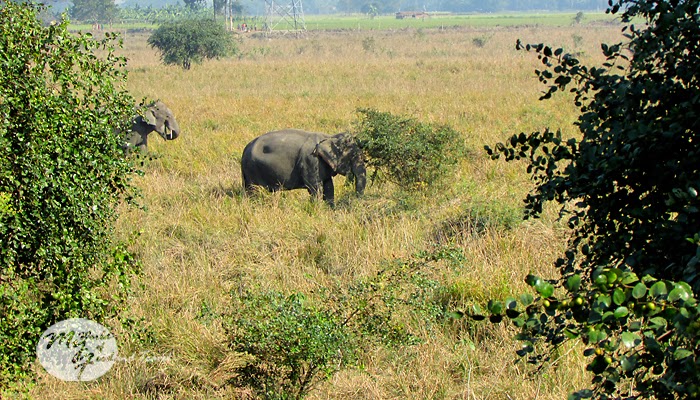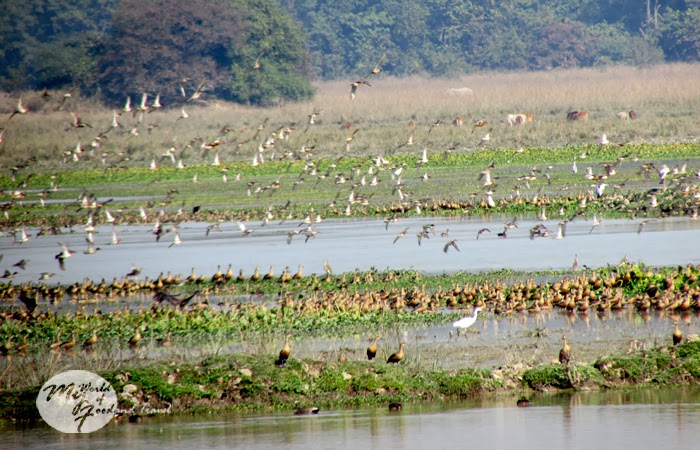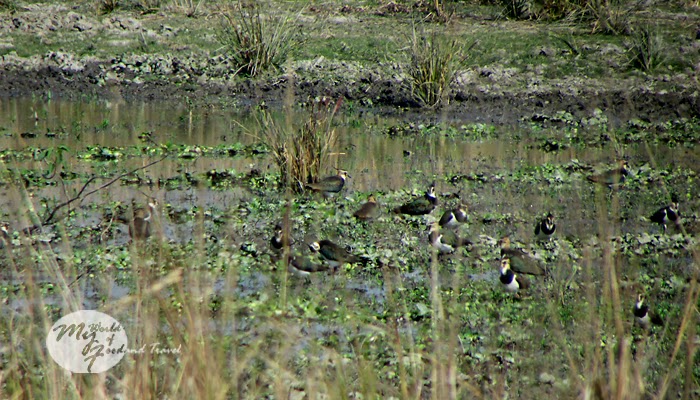A Morning in Pobitora Wildlife Sanctuary, Guwahati
I have spent most of my life in Guwahati, and yet I never ventured towards Pobitora Wildlife Sanctuary. I think we still had that nobody-can-come-close-to-Manas hangover and could not imagine any wildlife flourishing near such a busy city as Guwahati. “Pobitora is for city slickers who have never seen real wildlife,” we would scoff and offer Pobitora as a sight-seeing option to anyone who asked what was there to see in Guwahati. And so it continued, our feigned attitude towards Pobitora, till the time we became city slickers ourselves, a breed we had looked upon with contempt. You see, what goes around comes around.
This time, when I went home to Guwahati in December 2013, I gulped down all my previous proclamations and made way for Pobitora with my parents on a cold, misty, pre-dawn morning. The changes in the city brought over a ponderous mood but thankfully, the gloomy clouds of my mind lifted with the appearance of the sun. A sumptuous hot breakfast in a resort just at the entrance of the sanctuary further recharged me and I was ready to take up what Pobitora had to offer.
I was pleasantly surprised by the fact that Pobitora was so close to Guwahati, just around 35 kms. Practically my backyard! Another interesting point that I picked up was that Pobitora is located in Mayong, better known as the ‘Land of Black Magic ’. In fact, it is said that in ancient times, Mayong used to be the tantric epicenter of the country. People still talk about not daring to cross words with a native from Mayong as ‘bad things’ have been known to happen later. I somehow could not digest this as I looked upon the innocuous looking village settlements.
We parked the car near the forest office and Deta (my father) went off to book our jungle safari. Elephant safari was out of the question since my son was too young for that. I put Ma in charge of the little brat and walked up to the hanging bridge over a water stretch. The bridge was a beautiful sight to behold, flanked on both sides by amazing renditions of the Great Indian One-horned Rhinoceros, made out of bamboo strips.
I spied a lot of activity between the thick canopies of a large peepul tree near the bridge. Several species of birds were busy feasting on the fruit of the tree. I could make out a few Asian Koels as well as three species of barbets – lineated, coppersmith and blue-throated. Unfortunately, that day was the first time I had unpacked my new camera. I had not got accustomed to it and just could not locate the birds camouflaged amidst the green leaves. So, all the pictures here (and in Manas WLS later) have been clicked either in wrong settings or the subject has been out of focus. Although I did manage to get record shots of the lineated barbet and coppersmith barbet, the beautiful blue-throated barbet eluded me.
Coppersmith Barbet
Lineated Barbet
Meanwhile, Ma and Deta were waiting impatiently for me near the vehicle scheduled to take us on the safari. Pobitora is a relatively small sanctuary, encompassing 38.8 sq. km. of which only 16 sq.km. is effective rhino habitat, thus anointed with the epithet ‘highest density of rhinos’. There are around 110-115 rhinos in the area, who share their space with cows, goats and buffalos belonging to 33 villages surrounding the reserve. We were the only ones for the safari at that time and I was thankful for that. No sooner had we started out that I caught sight of an osprey and common kestrel hovering above a small water body. The osprey swooped down one instant and flew away with a fish glistening in its talons. Too bad I could not capture these in my camera from the rocking vehicle.
Osprey
Lesser Adjutant Stork
Elephants (domestic)
Our first rhino came to sight within 5 minutes of the safari. The lone creature was standing forlornly near a clump of bushes. I felt terrible thinking about the fate of these animals who were poached mercilessly for their horn. I had been told about a thriving market for rhino horns in South-east Asia, primarily Singapore, Hong Kong, China and Vietnam. The Middle-East and American markets were not far behind either. Is there no end to a person’s greed? Are these so-called developed nations filled with so many uneducated, superstitious morons? But then they would be filthy rich with degrees from the best universities in the world. And yet are they so ignorant of the fact that rhino horn is largely made up of the protein keratin, the chief component in hair, fingernails, and animal hooves? Isn’t there something called medical science to cure us of ailments than relying on rhino horns?
Great Indian One-horned Rhinoceros
“There is no future for rhinos in Assam,” Deta shook his head sadly. “They will be wiped out of the forests in the next 15 years.”
The forest guard accompanying us turned around from his front seat and assented.
“True, sir” he said. “We won’t be able to save this animal.”
Thus, we proceeded with the assurance that my son would not be able to witness this magnificent wildlife when he grew up.
Just as I was beginning to despair, Pobitora decided to lighten my mood. With the sound of swishing wings. Birds ahoy!! I had no idea that Pobitora held within it such an amazing variety and number of waders, ducks, geese and storks, most of them migratory. It was with uncontrolled joy that I surveyed the carpet of birds on the marshy lands. There they were, some of them flying around in flocks, some scouring for food underwater with upturned bottoms while some just sat bored (can they be called that?). Lesser adjutant storks and a few raptors circled around overhead. A multi-coloured group descended on the scene, revealing themselves to be the gorgeous northern lapwings. A few black-necked storks stood as if on vigil, dwarfing the ducks.
Northern Lapwings
There were a few wild boars amongst the birds, looking for food along the water, digging up soft mud. We also saw a number of buffalos but there was no way we could tell if they were the real deal or just domestic ones who had turned feral.
Wild Boars
Water Buffalo
We passed the grasslands and entered a heavily wooded area where we could see the mark of water on the trees (signs of dried water hyacinths) during the floods. Pobitora is located in the flood plains of the Brahmaputra and every year the wildlife of the area struggle to survive against the forces of nature. A lovely strain caught our ears and we looked up to see a crested serpent eagle perched atop a tree. I almost broke my neck trying to capture the fellow. We had come across another raptor, a changeable hawk eagle just a few minutes back and had also seen a greater spotted eagle. Not a bad day for raptor sighting.
Crested Serpent Eagle
Changeable Hawk Eagle
There were a number of small birds flitting in and out of trees and bushes but I could not identify them. I guess I only knew the birds from southern India. The birds from my hometown were aliens to me. Finally, the safari came to an end and we left the unpaved, rumbly jungle roads to return to the forest office via the concrete main road. But not before we sighted a few more rhinos, grazing amongst cattle, and witnessing a beautiful copper cover (or muga, the colour of the golden silk of Assam) lent by hundreds of lesser whistling ducks over a marshy field. A small group of openbill storks, whom Ma likened to a group of hunch-backed old men, bid us adieu.
Asian Openbill Stork
As I turned back to look at the rhino, peacefully grazing alongside the cattle, unmindful of scheming human beings, it hurt me to think that maybe it would not be there the next time I visited Pobitora. How I wish Deta’s words are proved wrong and these meek creatures live a long, long life. I hope my wish comes true.
White-breasted Kingfisher
Getting there: There are regular flights and trains to Guwahati. You can drive down from Guwahati, a distance of around 35 kms.
Best time to visit: November to March, before the floods take over.
Stay: You could opt to stay in any of the hotels in Guwahati or in one of the resorts in Pobitora itself. I visited the recently-opened Zizina Wild View Resort there and it seemed to be a lovely place, a tad expensive though. Phone number of Zizina Wild View Resort - +919854020651/9854030506.
Zizina Wild View Resort
Another place to stay in Pobitora is Maibong. There are two cottages on stilts. Phone number – +919845612196
Maibong Resort
List of birds sighted in Pobitora Wildlife Sanctuary (could not identify many):
Osprey, Common Kestrel, Barn Swallow, White Wagtail, Common Mynah, Asian Pied Starling, Grey-backed Shrike, Small Egret, Intermediate Egret, Grey Heron, Small Cormorant, Indian Cormorant, Bronze-winged Jacana, Indian Darter, Lesser Adjutant Stork, Black-necked Stork, Asian Openbill Stork, Gadwall, Northern Pintail, Lesser Whistling Duck, Fulvous Whistling Duck (?), Ruddy Shelduck, Greylag Geese, Bar-headed Geese, Eurasian Widgeon, Northern Lapwing, Grey-headed Lapwing, Coppersmith Barbet, Lineated Barbet, Blue-throated Barbet, Asian Koel, Great Tit, Large Woodshrike, White-breasted Kingfisher, Stork-billed Kingfisher, Rufus Treepie, Greater Spotted Eagle, Crested Serpent Eagle, Changeable Hawk Eagle, Spotted Dove.
Animals sighted in Pobitora:
Great Indian One-horned Rhinoceros, Wild Boar, Water Buffalo (?).






























Well documented, Sangeetha. Loved the captures too. You seem to have had a wonderful experience at Pobitora.
ReplyDeleteThanks! I really did enjoy those few hours.
DeleteHow come you missed the Greater Adjutant, the jewel of Assam's birdlife? I saw three from the road leading to Pobitora!
ReplyDeleteMust have been my bad luck that day, Joydeep. I did see quite a number of them at Deepor beel, though.
Delete